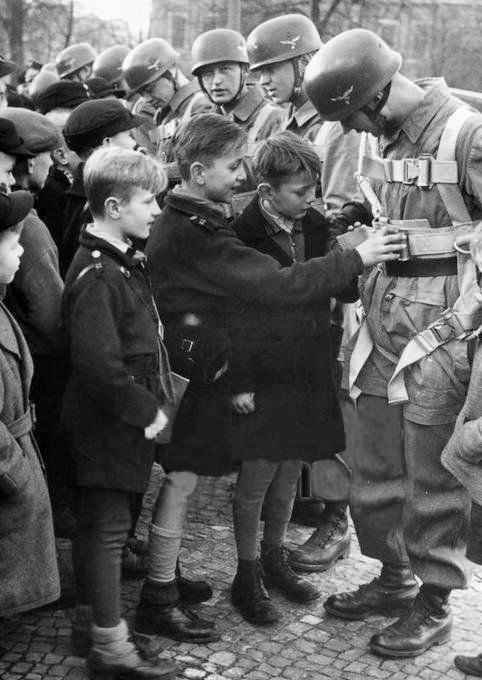
World War II: Airborn Units--Country Trends

Figure 1.--Here Hitler Youth boys examine the equipment of Fallschirmjäger troops. The photograph is undated, but was peobanly taken after the huge succes of the Western Offensive, it looks kike Fall 1940. Bitice thge soecuial helmets, fifferent grom the standard German helmets. Alao nitice the insignia on the gelnets, it is the Lufrwaffe indinia. The Fallschirmjäger wewe a Kuftwaffe formatio, not a Heer (Army) formation.
|
|
The Soviet Red Army led the way in developing airborn units. The first military parachutist drop was conducted by the Red Army after the development of knapsack parachutes (1930-33). It was a small drop from the wings of a plane -- some 62 parachutists. This was followed by a much larger operation with 1,000 parachutists. Other countries took note, but only the Germans, not the French, Japanese, and Italians, but notably the Americans and British did not take it seriously. It would be the Germans that would deploy the first airborn troops in combat--the Fallschirmjäger. They performed brilliantly in the Western Offensive (May 1940) and the success on Crete (May 1941)
Hitler was horrified by the high casulaties on Crete and decided against any furher drops. It is fascinating that some 6,000 casulaties on Create affected him so severly when the Barbarossa a few months later resulted in 1 million casualties -- and had no impact on him. The Japanese would be the next countru to employ airborn troops, using them to secure the vital oilfieds in the Dutch East Indies (April 1942). It was the German operations that changed minds in both America and Britain. This led to the development of both parchutte and glider forces in America and Britain. The gliders offered the ability to land ar least some supplies and heavy equipment with the parachusettes. They would be first used in combat durung the Allied invasion of Sicily (July 1943) and play a vital role in the Normandy D-Day operations (June 1944). Theu were also used in Market Garden and the Rhine crossing, but it was in the all-imprtant D-Day operations in which they played the most vital role. The Soviets did not conduct airborn opoeration on the Eastern Front against the Germans (1941-45). They did use them at the end of the War againsr the Jaoanese as they invaded Manchuiria (August 1945).
CIH -- WW II

Navigate the CIH Wirld War II Section:
[Return to Main World War II airborn page]
[Return to Main World War II specialized units page]
[Biographies]
[Campaigns]
[Children]
[Countries]
[Deciding factors]
[Diplomacy]
[Geo-political crisis]
[Economics]
[Home front]
[Intelligence]
[POWs]
[Resistance]
[Race]
[Refugees]
[Technology]
[Bibliographies]
[Contributions]
[FAQs]
[Images]
[Links]
[Registration]
[Tools]
[Return to Main World War II page]
[Return to Main war essay page]
Created: 4:01 AM 4/17/2020
Last updated: 4:01 AM 4/17/2020



